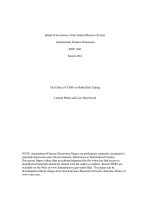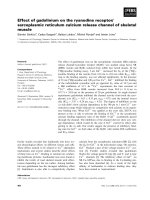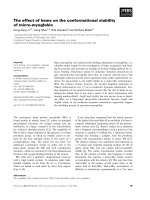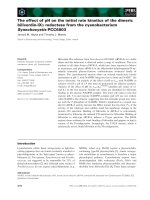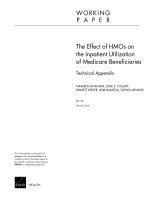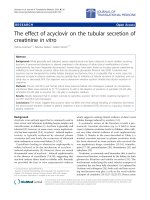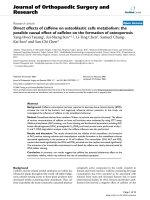Effect of radiation on the sensori neural auditory system and the clinical implications 1
Bạn đang xem bản rút gọn của tài liệu. Xem và tải ngay bản đầy đủ của tài liệu tại đây (43.45 KB, 17 trang )
i
EFFECT OF RADIATION ON THE SENSORI-NEURAL AUDITORY
SYSTEM AND THE CLINICAL IMPLICATIONS
LOW WONG KEIN CHRISTOPHER
(MBBS, FRCSEd, FRCSGlas, FAMS)
A THESIS SUBMITTED FOR THE DEGREE OF DOCTOR OF
PHILOSOPHY
DEPARTMENT OF OTOLARYNGOLOGY
NATIONAL UNIVERSITY OF SINGAPORE
2006
ii
Dedicated to:
My wife Stephanie Lim Yin Chan, whose sacrifice, patience, encouragement and love,
had been major contributions to the success of this thesis.
My colleague Goh Lip Kai, whose valuable contributions are greatly missed as a result of
his untimely demise.
iii
ACKNOWLEDGMENTS
I am very grateful to the following individuals and appreciate their contributions to the
success of this thesis:
1. Supervisor A/Prof Wang De-Yun for his sound advice, kind guidance, constant
encouragement and facilitation of funding.
2. Prof Peter Alberti, Dr Ruan Runsheng, A/Prof Mary Veronique Clement and A/Prof
Bay Boon Huat for their constructive advice
3. Prof Yeoh Kian Hian and Prof Tay Boon Keng for their support in my application for
admission to this course
4. Dr Michelle GK Tan, Dr Sun Li, Mr Alvin Chua, Mr Goh Lip-Kai, Dr Julian Wee, Dr
Toh Song Tar, Dr Fong Kam Weng, Mr Ronald Burgess, Ms Stephanie Fook Cheong
and Mr JS Tay for having assisted in the laboratories, clinics or publications.
5. Dr F. Kalinec from the House Ear Institute, USA who had very generously donated
the OC-k3 cell line
6. Prof S. Nagata, University of Osaka, Japan, for his consent to the use his illustration
7. Staff from the Dept of Otolaryngology, Singapore General Hospital and Department
of Therapeutic Radiology, National Cancer Centre who had facilitated the studies on
patients.
The studies had been partially supported by grants from National Medical Research
Council of Singapore, from the Department of Clinical Research, Singapore General
Hospital and from the National University of Singapore.
iv
PUBLICATIONS
Low WK, Burgess R, Fong KW, Wang DY. Effect of radiotherapy on retro-
cochlear auditory pathways. Laryngoscope. 2005 Oct; 115(10) :1823-6
Low WK, Toh ST, Wee J, Fook-Chong SM, Wang DY.Sensorineural hearing loss
after radiotherapy and chemoradiotherapy: a single, blinded, randomized study. J
Clin Oncol. 2006 Apr 20;24(12):1904-9
Low WK, Tan MG, Sun L, Chua AW, Goh LK, Wang DY Dose-dependant
radiation-induced apoptosis in a cochlear cell-line. Apoptosis 2006; 11:2127-36
v
TABLE OF CONTENTS
Acknowledgments
Summary
List of Tables
List of Figures
List of abbreviations
1. Introduction ………………………………………………………………………….1
2. Literature Review …………………………………………………………………….4
2.1 Characteristics of radiation-induced sensori-neural hearing loss
2.1.1 Animal studies
2.1.2 Human studies
2.1.3 Prevalence and epidemiology
2.1.4 Effect of radiation dose
2.1.5 High frequency hearing loss
2.1.6 Early vs late onset
2.2 Effect of radiation on retro-cochlear auditory pathways
2.2.1 The sensori-neural auditory pathways
2.2.2 Mechanisms of damage to the nervous system
2.2.3 Cochlear vs retro-cochlear damage
2.2.4 Cerebral and brainstem damage
vi
2.2.5 Spiral ganglia and cochlear nerve damage
2.2.6 Necropsy studies
2.2.7 Clinical studies
2.2.8 Gamma radiosurgery for acoustic neuroma
2.3 Combined effects of radiation and cisplatin on sensori-neural hearing
2.3.1 Combined chemo-radiotherapy for head and neck tumours
2.3.2 Properties of cisplatin
2.3.3 Combined ototoxicity of radiation and cisplatin
2.4 Cellular and molecular basis of ototoxicity
2.4.1 Apoptotic cell death
2.4.2 Necrotic cell death
2.4.3 Apoptosis in the cochlea
2.4.3.1 Ototoxicity
2.4.3.2 Caspases
2.4.3.3 Bcl-2 family
2.4.3.4 p53 protein
2.4.3.5 c-jun NH2-terminal pathway
2.4.3.6 Reactive oxygen species
2.5 Radiation-induced apoptosis
2.5.1 Radiobiology
vii
2.5.2 Radiation-induced cell death
2.5.3 Cellular targets of radiation
2.6 Intervention strategies based on cellular and molecular mechanisms
2.6.1 Protection against apoptosis
2.6.2 L-Acetylcysteine
2.6.3 Hair cell regeneration
2.6.3.1 Strategies
2.6.3.2 Genetic manipulation in the mammalian inner ear
2.6.3.3 Gene therapy in the mammalian cochlea
2.6.3.4 Stem cells in the inner ear
2.7 Using cochlear cell lines to study ototoxicity
2.7.1 Difficulty in studying the basic mechanisms of ototoxicity
2.7.2 Use of cell lines
2.7.3 Cell lines based on the transgenic mice
2.7.4 Cochlear cell lines from the transgenic mice
2.8 Summary of literature review
3. Objectives …………………………………………………………………………55
4. To study the effect of radiation on retro-cochlear pathways ………………………57
4.1 Abstract
4.2 Background
4.3 Material & Methods
4.3.1 Patients
viii
4.3.2 Audiological measurements
4.3.3 Radiotherapy technique
4.3.4 Radiation dose measurements
4.4 Results
4.4.1 Audiological effects of radiation
4.4.2 Radiation doses to the cochlea and the cochlear nerve
4.5 Comments
5. To study the synergistic ototoxic effects of radiation and cisplatin …………………76
5.1 Abstract
5.2 Background
5.3 Material & Methods
5.3.1 Patients
5.3.2 Treatment
5.3.3 Randomisation
5.3.4 Inclusion criteria
5.3.5 Audiological assessment
5.3.6 Statistical methods
5.4 Results
5.4.1 Analysis across groups
5.4.2 Analysis within each group
5.5 Comments
ix
6. To study radiation-induced apoptosis in a cochlear cell line………………………96
6.1 Abstract
6.2 Background
6.3 Materials & Methods
6.3.1 Cell culture
6.3.2 Cell viability assay
6.3.3 Apoptotic analysis
6.3.3.1 Flow cytometry
6.3.3.2 TUNEL assay
6.3.4 Microarray analysis
6.3.5 Western blot analysis
6.3.6 Measurement of intra-cellular reactive oxygen species generation
6.3.7 Statistical analysis
6.4 Results
6.4.1 Post-irradiation viability of cells is dose related
6.4.2 Dose-related apoptosis occurs predominantly at 72 hrs
6.4.3 Generation of reactive oxygen species is dose-related
6.4.4 Gene changes involved in apoptosis are dose related
6.4.5 Effect of radiation on p53 and c-jun
6.5 Comments
7. To study the protective effects of anti-oxidant L-NAC ……………………………122
7.1 Abstract
x
7.2 Background
7.3 Material & Methods
7.3.1 Cell culture
7.3.2 Cell viability assay
7.3.3 Flow cytometry
7.3.4 TUNEL assay
7.3.5 Confocal microscopic and fluorescence intensity analysis
7.3.6 Data analysis
7.4 Results
7.4.1 L-NAC cell viability
7.4.2 L-NAC protects against radiation-induced apoptosis
7.4.3 L-NAC inhibits ROS generation
7.5 Comments
8. Discussion ……………………………………………………………………….138
8.1 Radiation-induced SNHL in doses used clinically is an intra-cochlear event
8.2 Damage preferentially occurs in the basal coil of the cochlea
8.3 Radiation-induced SNHL based on an apoptotic model
8.3.1 A p53-dependent apoptotic model
8.3.2 A ROS-related apoptotic model
8.4 Radiation-induced SNHL based on multiple cell death mechanisms
9. Conclusion…………………………………………………………………………153
xi
10. Bibliography ……………………………………………………………………. 155
xii
SUMMARY
Irradiation-induced sensori-neural hearing loss (SNHL) is common after radiotherapy
(RT) to head and neck tumours, and yet the cellular and molecular mechanisms leading to
SNHL remain unclear. This problem is especially relevant in Singapore because
nasopharyngeal carcinoma (NPC) is common and RT is the main modality of treatment
for this condition. In this thesis, a prospective study on NPC patients treated by RT was
carried out. It confirmed that the auditory pathways received relatively high radiation
doses but the retro-cochlear pathways measured by brainstem evoked response
audiometry (BERA), remained functionally intact even up to 4 years post-radiation. This
suggests that the site of lesion in radiation-induced SNHL is at the cochlear and not the
retro-cochlear level. Combined chemo-radiation therapy using cisplatin (CDDP) is
increasingly used in head and neck cancers and CDDP is well known to be also ototoxic.
A single-blinded randomized study on NPC patients treated with RT alone and with
chemo-radiation therapy was carried out over a 2-year period. Combined therapy resulted
in a synergistic ototoxic effect, particularly for high frequency sounds in the speech
range. Based on a tonotopic arrangement of hair cells in the cochlea, the observed
patterns of hearing loss suggested preferential basal-to-apical hair cell destruction in the
cochlea. This could be related to mechanisms involving reactive oxygen species (ROS),
as the concentration of ROS in cochlear hair cells is also known to follow a basal-to-
apical pattern. Although it is known that ROS-induced apoptosis of cochlear cells occurs
in aminoglycoside and CDDP-induced ototoxicity, apoptotic cochlear cell death has not
been studied in radiation-induced ototoxicity. In this thesis, radiation-induced apoptosis
xiii
was confirmed by flow cytometry and TUNEL assay in a cochlear cell line (OC-k3). The
post-irradiation gene expression profiles were analysed by microarray studies and
proteins resulting from selected up-regulated genes were further investigated by Western
blotting. Intracellular generation of ROS was detected by 2’, 7’-dichlorofluorescein
diacetate (DCFDA), with comparisons made using confocal microscopy and fluorescence
intensity. It was found that radiation-induced apoptosis occurred in a dose-dependant and
ROS-related fashion with p53 possibly playing a major role. The anti-oxidant L-N-
Acetylcysteine (L-NAC) protected the cell line against radiation-induced apoptosis.
This thesis supports the feasibility of cochlear implantation, if one is clinically indicated,
for patients whose auditory pathways had previously been irradiated. For a successful
outcome after cochlear implantation, it is a prerequisite for the retro-cochlear pathways to
be intact. As the thesis confirmed that patients who had received RT and
concurrent/adjuvant chemotherapy experienced greater sensori-neural hearing loss
compared to those treated by RT alone, normal inner ear tissue tolerance once defined
only for radiotherapy alone should be redefined in chemo-radiotherapy. Based on a ROS-
related apoptotic model, there is the possibility of preventive strategies targeted at
different stages of the apoptotic process. Although multiple cell death mechanisms may
be involved in radiation-induced SNHL, they are likely to share common upstream
signaling process such as ROS generation. Therefore, the use of L-NAC in protecting
against radiation-induced SNHL clinically, looks promising. Not only has it already been
safely used in humans for other clinical indications, large doses can potentially be
administered topically through the middle ear with minimal systemic side effects.
xiv
LIST OF TABLES
Table Title Page
Table 1 Evoked response audiometric inter-wave latencies before, during
and after radiotherapy. 67
Table 2 Pre- and post-radiotherapy pure-tone audiogram bone-conduction
hearing levels in ears which recorded significant sensori-neural
hearing deterioration after treatment. 68
Table 3 Descriptive statistics of the minimum, maximum and mean point
doses delivered to each side of the cochlea and the internal auditory
meatus. 69
Table 4 Dose schedules for concurrent chemo-radiotherapy and
adjuvant chemotherapy 82
Table 5 Characteristics of patients in each treatment group 84
Table 6 Bone-conduction thresholds at the high and lower speech frequencies
for patients in the radiotherapy and chemo-radiotherapy groups at
different post-radiotherapy time-points 87
Table 7 An overview of the biological features of genes regulated by
gamma-irradiation in OC-k3 cells 115
xv
LIST OF FIGURES
Figure Title Page
Figure 1 Signal transduction for apoptosis 26
Figure 2 Beam's Eye View of lateral the post-nasal space field 63
Figure 3 Axial CT scan of the nasopharynx showing a computer
generated isodose plan 64
Figure 4 Box-plots to compare pre-treatment median sensori-neural
hearing thresholds in the lower speech frequencies with the
corresponding values at different post-radiotherapy
time-points for patients in the radiotherapy and
chemo-radiotherapy groups 88
Figure 5 Box-plots to compare pre-treatment median sensori-neural
hearing thresholds at 4kHz with the corresponding values at
different post-radiotherapy time-points for patients in the
radiotherapy and chemo-radiotherapy groups 89
Figure 6 Post-irradiation viability of cells is dose-related and MTT
absorbance values for different radiation doses at various
time-points are shown 109
Figure 7 Flow cytometry to show the effect of radiation dose on cell
cycle phase distribution 110
Figure 8 TUNEL assay confirms irradiation-induced apoptosis in OC-k3
cells at 72 hrs and is dose related 111
xvi
Figure 9 Radiation-induced generation of ROS is dose related 112
Figure 10 Overview of gene changes at 24 and 72 hrs after 5 and 20 Gy
of radiation 113
Figure 11 Western blot showing p53 and c-jun protein expression and
phosphorylation at various time-points after 0, 5 and 20Gy of
radiation 114
Figure 12 MTT assay shows post-irradiated OC-k3 cell viability is increased
by L-NAC 130
Figure 13 Flow cytometry showing the effect of L-NAC on the cell cycle
phase distribution in γ-irradiated OC-k3 cells 131
Figure 14 TUNEL assay confirms L-NAC protects against
radiation-induced apoptosis 132
Figure 15 L-NAC reduces intracellular ROS generated by γ-irradiation 133
xvii
LIST OF ABBREVIATIONS
BERA Brainstem evoked response audiometry
CDDP Cisplatin
DCFDA 2’, 7’-dichlorofluorescein diacetate
GSH Reduced Gluthathione
Gy Gray
IAM Internal Auditory Meatus
L-NAC L-N-Acetylcysteine
MTT 3-[4,5-dimethylthiazol-2-yl]-2,5-diphenyltetrazolium bromide
NPC Nasopharyngeal carcinoma
OHC Outer hair cells
ROS Reactive oxygen species
RT Radiotherapy
SNHL Sensori-neural hearing loss
TUNEL Terminal deoxynucleotidyl Transferase Biotin-dUTP Nick End Labeling

